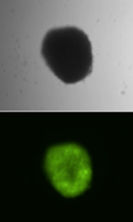Gonorrhea acquires a piece of human DNA
First evidence of gene transfer from human host to bacterial pathogen offers new view of evolution, disease
Advertisement
If a human cell and a bacterial cell met at a speed-dating event, they would never be expected to exchange phone numbers, much less genetic material. In more scientific terms, a direct transfer of DNA has never been recorded from humans to bacteria.
Until now. Northwestern Medicine researchers have discovered the first evidence of a human DNA fragment in a bacterial genome – in this case, Neisseria gonorrhoeae, the bacterium that causes gonorrhea. Further research showed the gene transfer appears to be a recent evolutionary event.
The discovery offers insight into evolution as well as gonorrhea's nimble ability to continually adapt and survive in its human hosts. Gonorrhea, which is transmitted through sexual contact, is one of the oldest recorded diseases and one of a few exclusive to humans.
"This has evolutionary significance because it shows you can take broad evolutionary steps when you're able to acquire these pieces of DNA," said study senior author Hank Seifert, professor of microbiology and immunology at Northwestern University Feinberg School of Medicine. "The bacterium is getting a genetic sequence from the very host it's infecting. That could have far reaching implications as far as how the bacteria can adapt to the host."
It's known that gene transfer occurs between different bacteria and even between bacteria and yeast cells. "But human DNA to a bacterium is a very large jump," said lead author Mark Anderson, a postdoctoral fellow in microbiology. "This bacterium had to overcome several obstacles in order to acquire this DNA sequence."
The paper is published in mBio.
The finding suggests gonorrhea's ability to acquire DNA from its human host may enable it to develop new and different strains of itself. "But whether this particular event has provided an advantage for the gonorrhea bacterium, we don't know yet, " Seifert said.
An ancient disease that sounds like gonorrhea is described in the Bible, noted Seifert, who has studied the disease for 28 years. Most of his research focuses on how the bacterium evades the human immune system by altering its appearance and modulating the action of white blood cells.
The gene transfer was discovered when the genomic sequences of several gonorrhea clinical isolates were determined at the Broad Institute in Cambridge, Mass. Three of the 14 isolates had a piece of DNA where the sequence of DNA bases (A's, T's, C's and G's) was identical to an L1 DNA element found in humans.
In Seifert's Feinberg lab, Anderson sequenced the fragment to reconfirm it was indeed identical to the human one. He also showed that this human sequence is present in about 11 percent of the screened gonorrhea isolates.
Anderson also screened the bacterium that causes meningitis, Neisseria meningitidis, and is very closely related to gonorrhea bacteria at the genetic level. There was no sign of the human fragment, suggesting the gene transfer is a recent evolutionary event.
"The next step is to figure out what this piece of DNA is doing," Seifert said.





















































